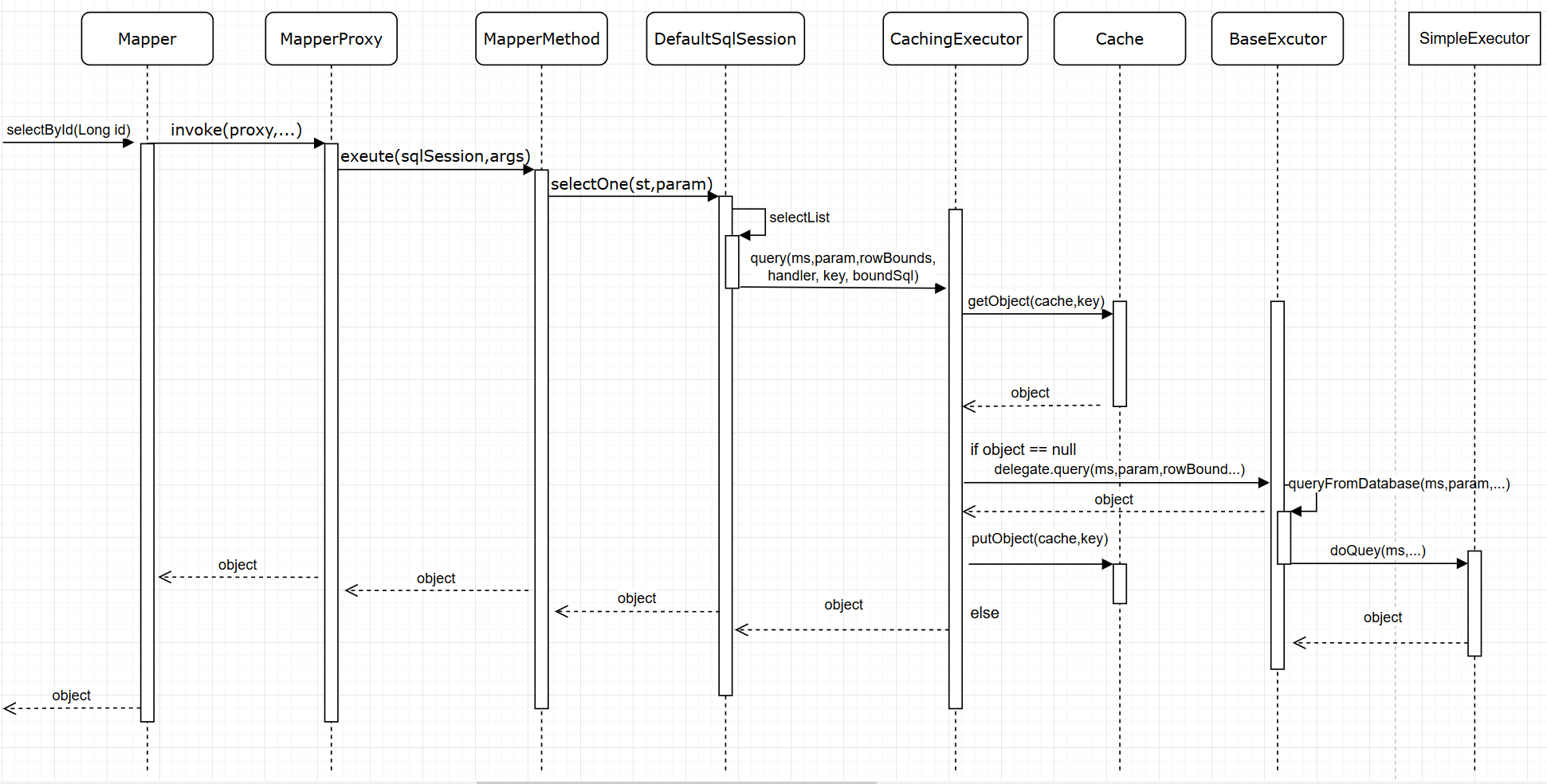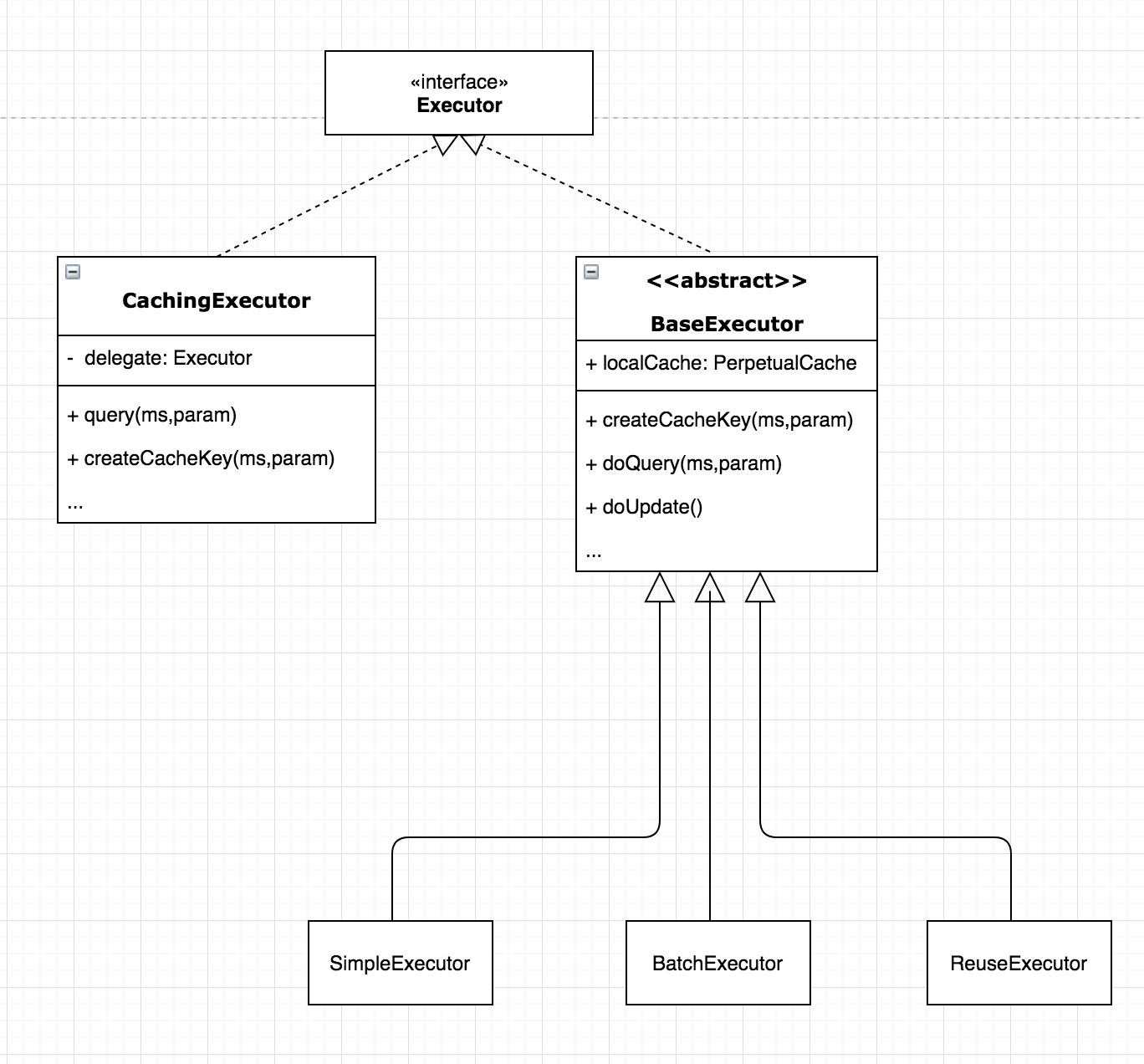MyBatis框架原理2:SqlSession執行過程
獲取SqlSession物件
SqlSession session = sqlSessionFactory.openSession();首先通過SqlSessionFactory的openSession方法獲取SqlSession介面的實現類DefaultSqlSession物件。
public interface SqlSessionFactory { SqlSession openSession(); SqlSession openSession(boolean autoCommit); SqlSession openSession(Connection connection); SqlSession openSession(TransactionIsolationLevel level); SqlSession openSession(ExecutorType execType); SqlSession openSession(ExecutorType execType, boolean autoCommit); SqlSession openSession(ExecutorType execType, TransactionIsolationLevel level); SqlSession openSession(ExecutorType execType, Connection connection); Configuration getConfiguration(); }
SqlSessionFactory介面提供一系列過載的openSession方法,其引數如下:
- boolean autoCommit:是否開啟JDBC事務的自動提交,預設為false。
- Connection:提供連線。
- TransactionIsolationLevel:定義事務隔離級別。
- ExecutorType:定義執行器型別。
DefaultSqlSessionFactory物件呼叫覆寫的openSession方法:
public SqlSession openSession() { return openSessionFromDataSource(configuration.getDefaultExecutorType(), null, false); }
得到一個定義了ExecutorType為configuration的預設執行器SIMPLE,事務隔離級別為null,JDBC事務自動提交為false的DefaultSqlSession物件。
獲取MapperProxy代理物件
有了DefaultSqlSession物件,以查詢一條資料為例,來看一下整個處理過程。
For example:
SqlSession session = sqlSessionFactory.openSession(); try { BlogMapper mapper = session.getMapper(BlogMapper.class); Blog blog = mapper.selectBlog(101); } finally { session.close(); }
MyBatis時序圖:

根據MyBatis文件推薦的方法,呼叫Mapper介面中的方法實現對資料庫的操作,上述例子中根據blog ID獲取Blog物件。 通過DefaultSqlSession物件的getMapper方法獲取的是一個MapperProxy代理物件,這也是Mapper介面不用實現類的原因。當呼叫BlogMapper中的方法時,由於BlogMapper是一個JDK動態代理物件,它會執行invoke方法,程式碼如下:
@Override
public Object invoke(Object proxy, Method method, Object[] args) throws Throwable {
try {
//判斷代理物件是否是一個類
if (Object.class.equals(method.getDeclaringClass())) {
return method.invoke(this, args);
} else if (isDefaultMethod(method)) {
return invokeDefaultMethod(proxy, method, args);
}
} catch (Throwable t) {
throw ExceptionUtil.unwrapThrowable(t);
}
//生成MapperMethod物件
final MapperMethod mapperMethod = cachedMapperMethod(method);
//執行execute方法
return mapperMethod.execute(sqlSession, args);
}
private MapperMethod cachedMapperMethod(Method method) {
MapperMethod mapperMethod = methodCache.get(method);
if (mapperMethod == null) {
mapperMethod = new MapperMethod(mapperInterface, method, sqlSession.getConfiguration());
methodCache.put(method, mapperMethod);
}
return mapperMethod;
}
...invoke方法判斷代理的物件是否是一個類,由於代理物件是一個介面,所以通過cachedMapperMethod生成一個MappedMethod物件,然後執行execute方法,execute方法程式碼如下:
public Object execute(SqlSession sqlSession, Object[] args) {
Object result;
switch (command.getType()) {
case INSERT: {
Object param = method.convertArgsToSqlCommandParam(args);
result = rowCountResult(sqlSession.insert(command.getName(), param));
break;
}
case UPDATE: {
Object param = method.convertArgsToSqlCommandParam(args);
result = rowCountResult(sqlSession.update(command.getName(), param));
break;
}
case DELETE: {
Object param = method.convertArgsToSqlCommandParam(args);
result = rowCountResult(sqlSession.delete(command.getName(), param));
break;
}
case SELECT:
if (method.returnsVoid() && method.hasResultHandler()) {
executeWithResultHandler(sqlSession, args);
result = null;
} else if (method.returnsMany()) {
result = executeForMany(sqlSession, args);
} else if (method.returnsMap()) {
result = executeForMap(sqlSession, args);
} else if (method.returnsCursor()) {
result = executeForCursor(sqlSession, args);
} else {
Object param = method.convertArgsToSqlCommandParam(args);
result = sqlSession.selectOne(command.getName(), param);
}
break;
case FLUSH:
result = sqlSession.flushStatements();
break;
default:
throw new BindingException("Unknown execution method for: " + command.getName());
}
if (result == null && method.getReturnType().isPrimitive() && !method.returnsVoid()) {
throw new BindingException("Mapper method '" + command.getName()
+ " attempted to return null from a method with a primitive return type (" + method.getReturnType() + ").");
}
return result;
}因為這裡是根據ID查詢一個物件,所以最終呼叫了DefaultSqlSession的selectOne方法,selectOne方法又呼叫自身selectList方法,最終將查詢操作委託給Executor:
@Override
public <T> T selectOne(String statement, Object parameter) {
// Popular vote was to return null on 0 results and throw exception on too many.
List<T> list = this.<T>selectList(statement, parameter);
if (list.size() == 1) {
return list.get(0);
} else if (list.size() > 1) {
throw new TooManyResultsException("Expected one result (or null) to be returned by selectOne(), but found: " + list.size());
} else {
return null;
}
}
public <E> List<E> selectList(String statement, Object parameter) {
return this.selectList(statement, parameter, RowBounds.DEFAULT);
}
@Override
public <E> List<E> selectList(String statement, Object parameter, RowBounds rowBounds) {
try {
//根據id獲取MappedStatement物件
MappedStatement ms = configuration.getMappedStatement(statement);
//wrapCollection方法處理集合引數
//委託Exector執行SQL
return executor.query(ms, wrapCollection(parameter), rowBounds, Executor.NO_RESULT_HANDLER);
} catch (Exception e) {
throw ExceptionFactory.wrapException("Error querying database. Cause: " + e, e);
} finally {
ErrorContext.instance().reset();
}
}Executor執行過程
Executor(執行器),才是真正對JDBC操作的例項,它的結構如下:

CachingExecutor: SqlSession預設會呼叫CachingExecutor執行器的query方法,先從二級快取獲取資料,當無法從二級快取獲取資料時,則委託給BaseExcutor進行操作,CachingExecutor執行過程程式碼如下:
public <E> List<E> query(MappedStatement ms, Object parameterObject, RowBounds rowBounds, ResultHandler resultHandler, CacheKey key, BoundSql boundSql)
throws SQLException {
//判斷是否有二級快取
Cache cache = ms.getCache();
if (cache != null) {
flushCacheIfRequired(ms);
if (ms.isUseCache() && resultHandler == null) {
ensureNoOutParams(ms, boundSql);
@SuppressWarnings("unchecked")
//從二級快取獲取資料
List<E> list = (List<E>) tcm.getObject(cache, key);
//如果二級快取沒有資料則委託給BaseExcutor進行操作
if (list == null) {
list = delegate.<E> query(ms, parameterObject, rowBounds, resultHandler, key, boundSql);
tcm.putObject(cache, key, list); // issue #578 and #116
}
return list;
}
}
//如果沒有二級快取則委託給BaseExcutor進行操作
return delegate.<E> query(ms, parameterObject, rowBounds, resultHandler, key, boundSql);
}BaseExecutor是一個抽象類,查詢操作時BaseExecutor首先從一級快取獲取資料,如果沒有則由其子類來進行資料庫操作,其query方法如下:
public <E> List<E> query(MappedStatement ms, Object parameter, RowBounds rowBounds, ResultHandler resultHandler, CacheKey key, BoundSql boundSql) throws SQLException {
ErrorContext.instance().resource(ms.getResource()).activity("executing a query").object(ms.getId());
if (closed) {
throw new ExecutorException("Executor was closed.");
}
if (queryStack == 0 && ms.isFlushCacheRequired()) {
clearLocalCache();
}
List<E> list;
try {
queryStack++;
//從一級快取獲取資料
list = resultHandler == null ? (List<E>) localCache.getObject(key) : null;
if (list != null) {
handleLocallyCachedOutputParameters(ms, key, parameter, boundSql);
} else {
//如果一級快取沒有資料,則從資料庫獲取
list = queryFromDatabase(ms, parameter, rowBounds, resultHandler, key, boundSql);
}
} finally {
queryStack--;
}
if (queryStack == 0) {
for (DeferredLoad deferredLoad : deferredLoads) {
deferredLoad.load();
}
// issue #601
deferredLoads.clear();
if (configuration.getLocalCacheScope() == LocalCacheScope.STATEMENT) {
// issue #482
clearLocalCache();
}
}
return list;
}最後,我們例子中的查詢操作交給了SimpleExecutor這個子類,可以看到SimpleExecutor直接呼叫了JDBC的程式碼,最終得到了我們查詢的結果,其方法程式碼如下:
public <E> List<E> doQuery(MappedStatement ms, Object parameter, RowBounds rowBounds, ResultHandler resultHandler, BoundSql boundSql) throws SQLException {
Statement stmt = null;
try {
Configuration configuration = ms.getConfiguration();
StatementHandler handler = configuration.newStatementHandler(wrapper, ms, parameter, rowBounds, resultHandler, boundSql);
stmt = prepareStatement(handler, ms.getStatementLog());
return handler.<E>query(stmt, resultHandler);
} finally {
closeStatement(stmt);
}
}
private Statement prepareStatement(StatementHandler handler, Log statementLog) throws SQLException {
Statement stmt;
Connection connection = getConnection(statementLog);
stmt = handler.prepare(connection, transaction.getTimeout());
handler.parameterize(stmt);
return stmt;
}